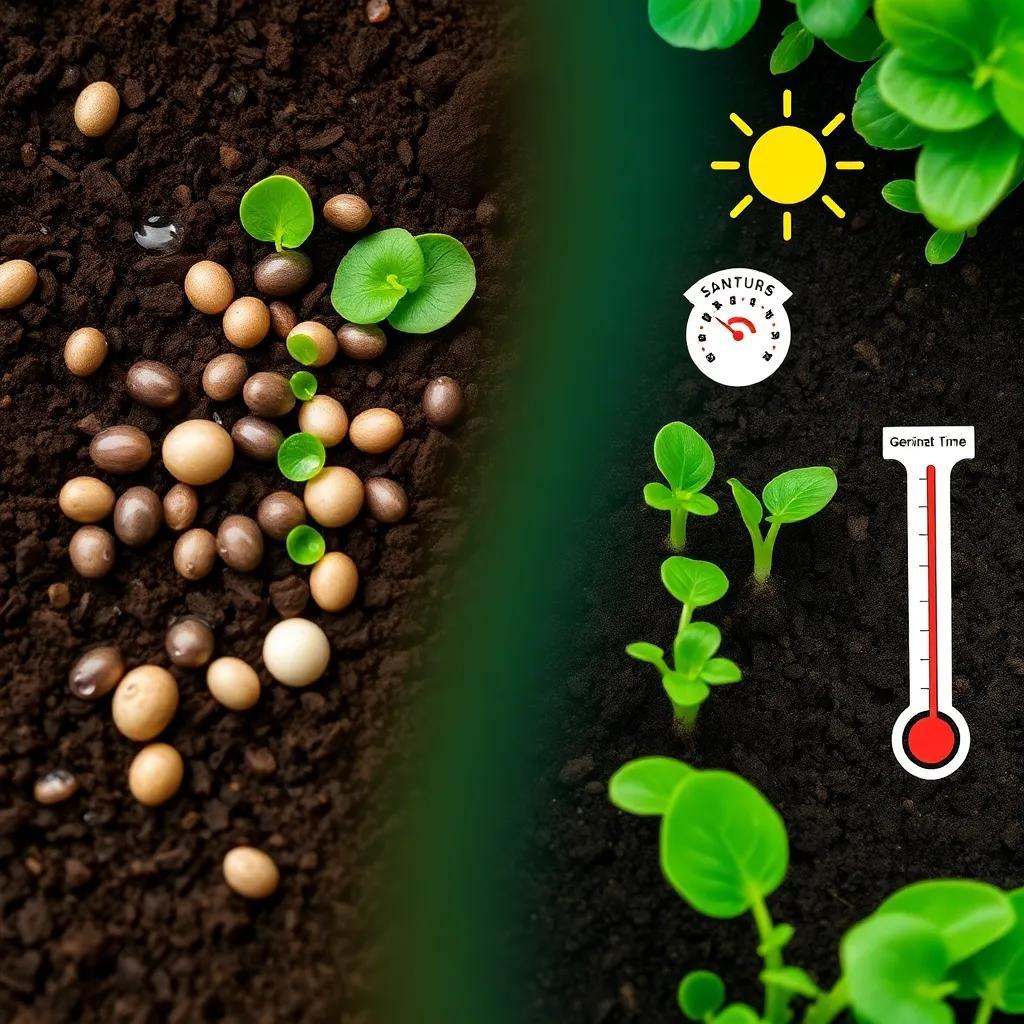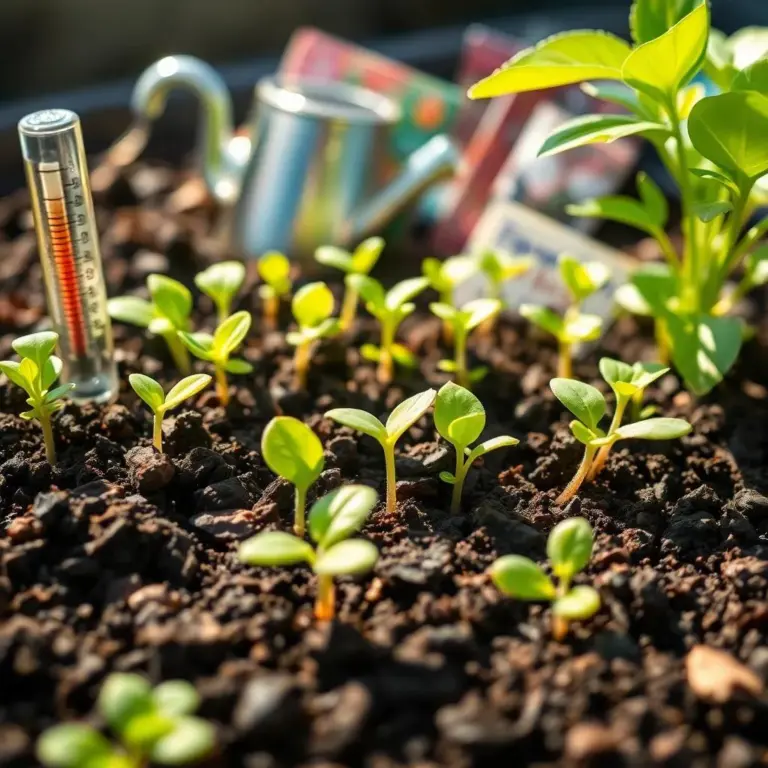Have you ever wondered how those tiny seeds turn into the beautiful plants we love? Gardening is like magic, and I’m here to share everything I’ve learned about getting seeds to sprout and thrive! From understanding what makes them grow to tips that speed up the process, let’s dive into the enchanting world of seed germination together!
Factors Affecting Seed Germination Time
When it comes to getting those seeds to sprout, several factors can influence how long it takes! Here’s what I’ve discovered through my gardening journey. Understanding these can make you a successful gardener in no time!
- Water: Seeds need moisture to kick-start the germination process. Without enough water, they simply won’t wake up! But too much can drown them, so finding that sweet spot is key.
- Temperature: Did you know that different seeds have their own temperature preferences? Some are like me, loving the warmth, while others prefer the cooler side. Most seeds like a cozy spot between 60°F and 75°F (15°C to 24°C). So keep an eye on that thermostat!
- Light: Light is another magic ingredient! Some seeds want to bask in the sun to germinate, while others prefer a little darkness. Knowing what your seeds crave will help them sprout sooner.
- Oxygen: Just like we need to breathe, seeds do too! They require oxygen to germinate. So, make sure your soil is nicely aerated to allow that oxygen to flow!
- Seed Quality: The seeds themselves play a big role. High-quality seeds, free from diseases and defects, have a better chance of germinating quickly. Don’t skimp on this – your plants will thank you!
With these factors in mind, you can create an environment that makes seeds want to sprout! Keep experimenting and adjusting until you find what works best for you and your garden. Happy planting!
Average Germination Times for Common Seeds
Now that we’ve tackled what affects seed germination, let’s talk about how long these little guys actually take to get growing! It’s like waiting for popcorn to pop – you want to know when to expect that delightful explosion!
Here are average germination times for some common seeds:
- Lettuce: 7 to 14 days – these are quick little sprouters!
- Tomatoes: 7 to 14 days – perfect for summer salads.
- Carrots: 14 to 21 days – they take their sweet time but are oh-so-worth it!
- Beans: 7 to 10 days – nice and speedy, just like their name!
- Cucumbers: 7 to 10 days – a great addition to summer dishes.
- Radishes: 4 to 7 days – these tiny seeds are the fastest of the bunch!
Isn’t it exciting to think about how quickly things can sprout? Of course, these times can change, depending on factors like seed variety and growing conditions. Just keep an eye on your garden, and don’t be afraid to make some adjustments if things seem a bit slow.
Knowing these averages helps you plan your gardening activities effectively! So mark your calendars and get ready to enjoy those vibrant plants popping up in no time! Happy gardening!

Techniques to Accelerate Seed Germination
Are you as excited as I am to see those seeds sprout? Well, luck is on your side! There are some awesome techniques you can use to help your seeds germinate faster. Let’s sprinkle in some gardening magic!
- Pre-soaking: Soaking seeds overnight can soften their tough outer shells. This is especially helpful for seeds like beans or peas. Just pop them in a bowl of water and let them soak up the goodness!
- Scarification: Some seeds, like those from plants with hard coatings, need a little help to absorb water. By gently nicking the seed coat or lightly sanding it, you can help them wake up faster. It’s like giving them a little nudge!
- Stratification: Certain seeds need a cold nap before they can grow. By placing them in a fridge for a couple of weeks (in a sealed bag, of course), you can mimic winter conditions and break their dormancy.
- Proper Watering: Keep that soil consistently moist, but not soggy! I like to mist the soil to maintain moisture without drowning the little guys.
- Temperature Control: Most seeds love warmth! Using a heating mat or placing your seed trays in a sunny spot can help create a cozy environment.
With these techniques, you’ll be on your way to sprouting seeds in no time! Just remember to be patient – good things come to those who wait!
Understanding Seedling Growth Requirements
Once your seeds have sprouted into little seedlings, it’s time to help them thrive! Understanding what your seedlings need can make a world of difference. It’s like giving them the VIP treatment in the garden.
- Light: Seedlings need plenty of light to grow strong! If they don’t get enough, they might become weak and leggy. I usually place my seedlings near a bright window or use grow lights to keep them healthy.
- Temperature: Most seedlings thrive in temperatures between 60°F and 75°F (15°C to 24°C). If it’s too cold or too hot, they won’t grow well. Keeping an eye on the thermometer can help you find the right balance.
- Watering: Be consistent, but don’t overdo it! Water your seedlings to keep the soil moist, but let it dry out slightly between waterings. This helps them develop strong roots.
- Soil Quality: Using nutrient-rich, well-draining soil helps seedlings flourish. I always opt for a quality seed-starting mix that encourages aeration and moisture retention.
- Nutrient Availability: Once your seedlings have their first true leaves, they can start benefiting from a balanced liquid fertilizer. It’s like a little boost to help them grow!
By paying attention to these growth requirements, you’ll help your seedlings thrive and transform into healthy, vibrant plants. I can’t wait to see your garden flourish!
Tips for Promoting Healthy Seedling Development
Seeing your seedlings grow is one of the most rewarding parts of gardening! To keep them healthy and strong, here are a few tips that I swear by. Trust me, it’s like nurturing a tiny green miracle!
- Provide Proper Spacing: As seedlings grow, they need space! If they’re too crowded, they may struggle for nutrients and light. Make sure to transplant or thin them out when necessary.
- Monitor Watering: Keep an eye on the moisture levels. Water your seedlings deeply, but let the soil dry slightly between waterings. This helps encourage root growth.
- Implement Proper Ventilation: Good air circulation is essential! If seedlings are too cramped and stuffy, diseases can develop. I like to keep my growing area well-ventilated to support healthy growth.
- Gradually Introduce Outdoor Conditions: If you plan to move your seedlings outside, don’t forget to harden them off! Start by placing them outside for a few hours a day, gradually increasing the time. It helps them adjust to their new home!
- Organic Pest Control: Keep an eye out for pests. Regularly inspect your seedlings and use organic pest control methods to keep them safe. No one likes uninvited guests!
By following these tips, you’ll be well on your way to healthy, thriving seedlings that can grow into beautiful plants. Happy gardening, and may your seedlings flourish!

